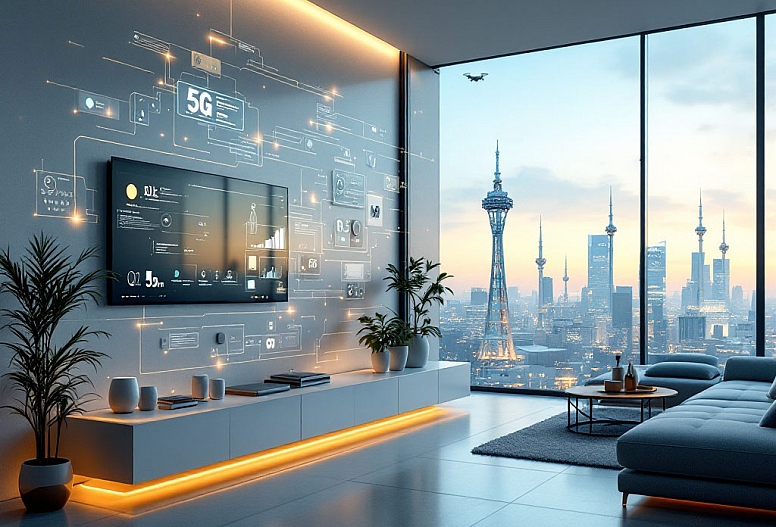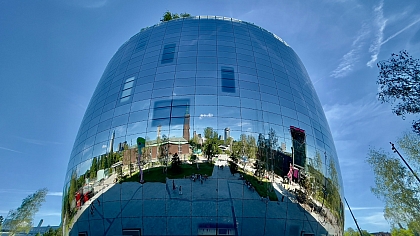
Smart Living & the Future of Connectivity
What if your home could think for itself, anticipating your needs before you even ask? Home connectivity has come a long way, evolving from basic internet access to intelligent living spaces that enhance comfort, efficiency, and security.
Thanks to AI, 5G, and IoT, smart devices now communicate seamlessly, creating personalised experiences from voice-controlled lighting to advanced security systems. We will discuss how global technology is revolutionising smart living, the key innovations driving this transformation, and what the future holds for home automation.
The Evolution of Home Connectivity
From Basic Connectivity to Smart Homes
Home connectivity was once limited to landlines and dial-up internet. As technology advanced, high-speed broadband, Wi-Fi, and mobile networks became essential for modern households. Today, homes with smart technology rely on ultrafast networks and intelligent devices that make everyday life more convenient.
The shift from manual to automated home functions has introduced new possibilities. With connected devices, homeowners can now remotely control lighting, appliances, and security systems. This transformation has paved the way for the seamless integration of smart home technology.
The Role of IoT in Smart Homes
The Internet of Things (IoT) is the foundation of smart homes, allowing devices to
connect and interact in real time. From smart thermostats that adjust room temperature to AI-powered security cameras that provide live surveillance, IoT enhances home efficiency and security.
By integrating smart devices into a single ecosystem, homeowners can enjoy automated processes that learn from daily habits. This means homes are not just connected, they are intelligent, responsive, and highly efficient.
In regions with strong technological infrastructure, connectivity plays an even bigger role. The UK, with its commitment to digital innovation and expanding 5G networks, is a prime example of how technology is enhancing everyday connectivity.
Thanks to widespread mobile coverage and user-friendly digital services, residents and visitors can enjoy reliable access almost anywhere. For travellers and remote workers, access to a UK esim ensures seamless connectivity, allowing smart devices to function optimally without disruptions.
Key Technologies Shaping Smart Living

Artificial Intelligence (AI) and Machine Learning
AI is making smart homes more intuitive and adaptive. With AI-driven automation, devices can learn user preferences and adjust accordingly. For example, smart lighting systems dim or brighten based on natural daylight, while AI-powered assistants can control multiple home functions with simple voice commands.
Machine learning takes automation a step further by analysing user behaviour to optimise home efficiency. AI can suggest energy-saving settings, automate daily routines, and even detect security threats, making smart homes safer and more sustainable.
5G Connectivity and Faster Networks
The rollout of 5G technology is enhancing home connectivity by offering faster speeds, lower latency, and improved reliability. This ensures that multiple smart devices can operate smoothly without lag or interruptions.
With 5G, real-time communication between devices becomes effortless. Security cameras can stream high-definition video without delays, smart home hubs can process commands instantly, and home automation systems respond in real time. As 5G networks expand, smart homes will become even more advanced and interconnected.
Edge Computing for Better Performance
Edge computing allows data processing to happen closer to the device rather than relying on distant cloud servers. This improves response times, enhances security, and reduces internet bandwidth usage.
For smart homes, this means faster automation, more secure data storage, and improved device performance. Instead of waiting for cloud-based processing, edge computing enables smart assistants, security systems, and appliances to work efficiently without delays.
How Global Technology is Driving Smart Home Adoption
Sustainable and Energy-Efficient Solutions
Smart homes are becoming more eco-friendly, thanks to energy-efficient innovations. Automated systems help reduce energy waste by optimising power consumption. Smart thermostats regulate temperatures based on room occupancy, while smart lighting turns off automatically when no one is present.
Homeowners can now monitor their energy use through mobile apps and receive real-time insights on how to save power. These sustainable solutions not only lower electricity bills but also contribute to a greener and more efficient lifestyle.
AI Assistants and Home Automation
AI-powered voice assistants like Alexa, Google Assistant, and Siri are now central to smart home management. These assistants can control lighting, play music, adjust room temperatures, and even answer security alerts.
Beyond basic commands, AI assistants learn user habits and automate daily tasks accordingly. Whether setting reminders, suggesting the best lighting for relaxation, or managing multiple devices at once, AI is revolutionising how we interact with our homes.
Security and Privacy in Smart Homes
The more systems in homes become interconnected, the more they need cybersecurity and privacy protection. Smart homes process information and, hence, serve as potential targets for cyber threats.
Some other points of interest include much-needed biometric authentication, encrypted connections, and the introduction of artificial intelligence-based cybersecurity solutions. Other issues include timely software updates and strong password-strengthening benefits.
The Future of Smart Living

Predictive Maintenance and Self-Healing Systems
In the future, these smart homes would be equipped with self-monitoring systems to diagnose and eliminate potential problems before they occur. AI diagnostics would identify electrical faults, plumbing leaks, or appliance failures before they show signs, eliminating inconveniences and saving money.
By effectively integrating predictive technology, home occupants will be able to live more simply and efficiently. The smart systems, instead of waiting for repairs, will alert users and offer solutions beforehand.
Seamless Integration of Smart Devices
As smart home adoption begins to blossom, the demand for seamless device integration is growing starkly. Future smart home ecosystems will ensure that devices from different brands can communicate and operate effortlessly.
With universal compatibility standards in place, smart home technology will be made user-friendly. This allows homeowners to choose devices customised to their lifestyles without having to worry about compatibility issues.
Immersive Home Experiences with AR and VR
Augmented Reality (AR) and Virtual Reality (VR) will revolutionise how we experience home entertainment, design, and remote workspaces. With AR, homeowners can see how a purchase will fit within their space before actually buying it, whereas VR allows for immersive gaming and virtual meeting experiences.
As these technologies advance, they will redefine how we interact with our living spaces, offering enhanced customisation and engagement.
FAQs
What is the future technology for smart homes?
Smart homes may very well be more integrated with 5G connectivity, the Internet of Things, and advanced AI technology. This paves the way for deeper and deeper integration of automation, security upgrades, energy efficiency, and personalization with minimal intervention from users.
What is the role of artificial intelligence in future smart homes?
AI will incorporate predictive automation so that it observes user habits and recommends ideal lighting temperatures, security, and appliances toward a communicative, efficient, and ultimately simple smart-home experience.
How is technology changing the homes we live in?
Technology constructs an intelligent ecosystem that provides ease of use, security, and energy efficiency through automation, voice control, smart appliances, and intermingling systems, leading to an easier user life.
Smart Living is the Future
Connected Home with futuristic technology developing at a fast pace. From AI and 5G to IoT, smart homes are becoming increasingly intelligent, efficient, and sustainable. From automated energy management to high-security levels, technology is changing lives to a great extent.
As improvements continue, home automation may become seamless, security should become enhanced, and smart living would become the new norm. Now is the time to explore new-age solutions and step into the next generation of connected, smart living.










